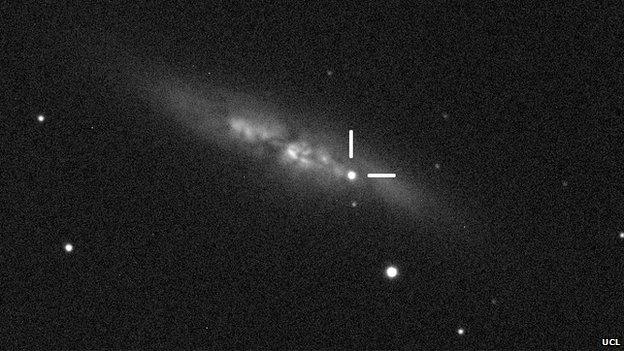Nearby supernova dazzles astronomers
- Published

The supernova may be visible to stargazers through binoculars - and could grow brighter in coming weeks
An exploding star has been spotted in the night sky - the closest supernova to Earth that has been seen in decades.
The dramatic event happened 12 million light years away in Messier 82 - known as the cigar galaxy for its shape.
It was discovered by undergraduates during a telescope class at the University of London Observatory.
"One minute we're eating pizza then five minutes later we've helped to discover a supernova. I couldn't believe it," said student Tom Wright.
"It reminds me why I got interested in astronomy in the first place."

Before and after: The supernova appears like a 'new star' in the lower image
The students from University College London were taking part in a 10-minute lesson with astronomer Dr Steve Fossey when they noticed what appeared to be a "new star".
"We pointed the telescope at Messier 82 - it's quite a bright galaxy, quite photogenic. But as soon as it came up on screen, it didn't look right to me," Dr Fossey told BBC News.
"We fired up another telescope, we got another frame - and that was when we knew it was a supernova."
The "fluke" discovery led to a global scramble to acquire confirming images and spectra from the dazzling object.
It has now been confirmed by the International Astronomical Union as a supernova - a violent blast of energy and light that is hurled out as a star dies.
It has taken 12 million years for the light to reach us. But though this may seem like a long way away, scientists say this is the closest supernova to be spotted since SN1987A in the Large Magellanic Cloud and SN1993J in Messier 81.
Scientists says it could grow even brighter over the coming weeks, before fading away.
If this happens, astronomers in the northern hemisphere may be able to spot it with binoculars, by looking between the Great Bear and the Little Bear.
- Published7 January 2014
- Published10 January 2013
- Published27 November 2013